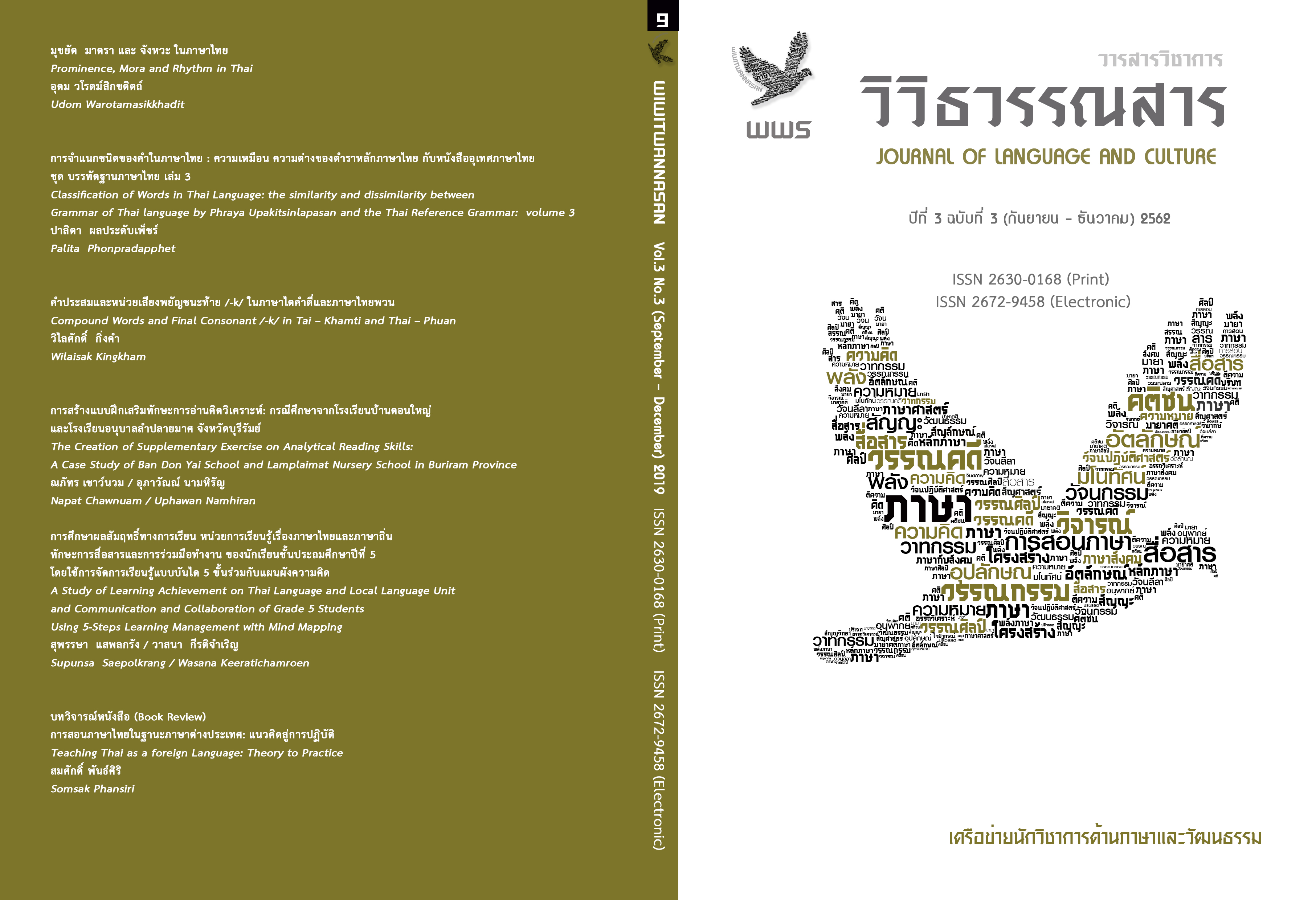การจำแนกชนิดของคำในภาษาไทย : ความเหมือน ความต่างของตำราแนวเดิมกับตำราใหม่
Main Article Content
บทคัดย่อ
บทคัดย่อ บทความวิชาการนี้นำเสนอข้อเปรียบเทียบการจำแนกชนิดของคำในภาษาไทยระหว่างตำราแนวเดิม คือหลักภาษาไทยของพระยาอุปกิตศิลปสาร กับตำราใหม่ คือ หนังสืออุเทศภาษาไทย ชุด บรรทัดฐานภาษาไทย เล่ม 3 พบว่าตำราทั้งสองมีแนวคิดในการจำแนกชนิดของคำที่ต่างกันหลายประเด็น ได้แก่ 1) ประเด็นเรื่องคำสมุหนามที่ไม่ปรากฏในตำราใหม่ 2) ประเด็นเรื่องคำวิภาคสรรพนามที่มีสาระสำคัญบางประการต่างจากคำสรรพนามแยกฝ่าย 3) ประเด็นคำถามว่าประพันธสรรพนามควรจัดอยู่ในหมวดคำสรรพนามหรือไม่ 4) ประเด็นคำถามว่ากริยาสภาวมาลา จัดเป็นคำกริยาหรือคำนาม 5) ประเด็นเรื่องความแตกต่างของกริยาคุณศัพท์กับคำวิเศษณ์ 6) ประเด็นเรื่องคำกริยาชนิดใหม่ที่ไม่ปรากฏในตำราแนวเดิม 7) ประเด็นคำถามว่ากริยานุเคราะห์เป็นคำกริยาหรือไม่ 8) ประเด็นเรื่องหน้าที่และความหมายอันหลากหลายของคำวิเศษณ์ตามตำราแนวเดิม 9) ประเด็นเรื่องความเหมือนและความต่างของคำบุพบทตามตำราแนวเดิมกับตำราใหม่ 10) ประเด็นเรื่องความแตกต่างระหว่างคำสันธานกับคำเชื่อม และ 11) ประเด็นคำถามว่าคำบางคำควรนับว่าเป็นคำอุทานหรือไม่
Article Details
ลิขสิทธิ์ของบทความเป็นของวารสาร การพิมพ์ซ้ำจะต้องได้ร้บการอนุญาตจากบรรณาธิการวารสาร
เอกสารอ้างอิง
Bandhumedha, N. (2015). Waiyakonthai (In Thai) [ Thai Grammar] (7th ed.). Bangkok: Project of Research Publication of the Faculty of Arts, Chulalongkorn University.
Chinloet, N. (2006). Kan chamnaek muat kham nai tamra lak waiyakon thai : lak withikhit lai thruesadi. (In Thai) [Part of Speech in Textbooks of Thai Grammar: Varity of Concepts and Theories]. VANNAVIDAS, 6(1), 189-216
Diphadung, S. (2000). Sathanaphap kan wichai thang phasasat nai prathet thai : rabop nuai kham thueng rabop prayok lae khwammai (In Thai) [A Trend of research in linguistics in Thailand: system of word, sentence and meanining. Journal of Language and Culture, 19 (2), 42-77.
Mekphaibun, S. (Trans.). (2019). Kan klap ma khong chaochai (num ) noi (In Thai) [The Return of the Young Prince ].(2nd ed.). Bangkok: Phapkanphim.
Phonpradapphet, P. (2018). Lak phasa thai chut (in Thai) [Principles of Thai Language] Buri Ram: Winai
Printing House 2509.
Panupong, W. et. al. (1989). Khrongsang phasa thai : rabop waiyakon (in Thai) [ A Structure of Thai Language: Grammatical System]. (10th ed.). Bangkok: Ramakhamhaeng University Press.
Panupong, W. et al. (2012). Nangsue uthet phasa thai : chut banthatthan phasa thai lem 3 : chanit khong kham wali prayok (In Thai) [ Thai Reference Book: Standard Thai Language Volume 3: Type of Word, Phrase, Sentence. (2nd ed.) Bangkok: Thai Language Institute, Bureau of Academic Affairs and Educational Standards Office of the Basic Education Commission, Ministry of Education.
Prasitratsint, A (2000). Chanit khong kham nai phasa thai : kan wikhro thang wakkayasamphan doi asai thankhomun thang phasa thai patchuban song lan kham (in Thai) [ Part of Speech in Thai: A Syntactic Analysis Based on a Two-milion-word corpus of Current Thai] Bangkok: The Thailand Research Fund.
Phraya Upakitsinlapasan. (1981). Lak phasa thai ( akkharawithi wachi wiphak wakkayasamphan chanthalak) (In Thai) [Principles of Thai Language: Phonology, Morphology, Syntax, and Prosody.] Bangkok: Thaiwatthanaphanit.
Thonglo, K. (2013). Lak phasa thai (In Thai) [Principles of Thai Language]. (54th ed.). Bangkok: Ruamsan. Warotamasikkhadit, U. (2535). Phasasat bueangton (in Thai) [Introduction to Linguistics]. (4th ed.). Bangkok: Ramkhamhaeng University Press.


